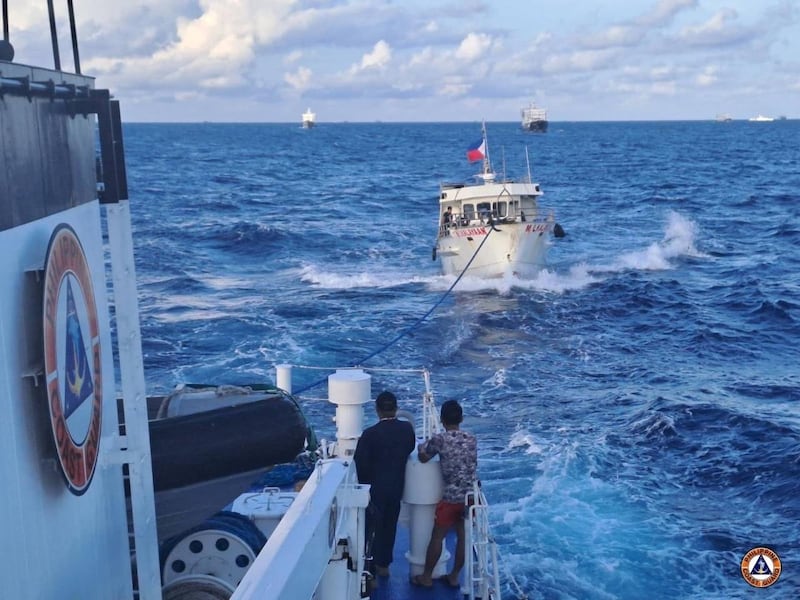Beijing and Manila traded accusations on Sunday morning with each side claiming its ships were harassed and rammed by the other.
A Philippine spokesman said Philippine civilian supply vessels on a routine resupply and rotation mission to the BRP Sierra Madre – the old landing ship that Manila deliberately grounded on the Second Thomas Shoal to serve as an outpost in 1999 – were “harassed, blocked, and executed dangerous maneuvers on” by the Chinese coast guard and maritime militia vessels.
Jay Tarriela, the Philippine coast guard's spokesperson, posted on the social media site X a statement by the National Task Force for the West Philippine Sea, the part of the South China Sea under Manila's jurisdiction, saying that the resupply boat Unaizah Mae 1 (UM1) was rammed by the Chinese coast guard ship CCG 21556.
The Chinese coast guard earlier issued a statement saying that at 06:39 a.m. the UM1 "ignored CCG repeated stern warnings, violated the COLREGs (Convention on the International Regulations for Preventing Collisions at Sea), swerved in an unprofessional and dangerous manner, and deliberately collided into the CCG boat 21556, resulting in scratches, for which the Philippines is fully responsible."
Ship ramming is generally considered an act of violence and could cause serious damage to vessels, as well as injuries to the crew on board.
There have been instances of ship ramming in the South China Sea but no state has ever officially sanctioned this dangerous tactic.
The previous time Manila accused Chinese vessels of ramming its ships was on Oct. 22, also in the waters off the Second Thomas Shoal, known by Filipinos as Ayungin Shoal and by the Chinese as Ren’ai Jiao. China denied it.
The Philippines afterwards summoned the Chinese ambassador and filed a diplomatic protest against China’s action.
The United States also expressed concern, issuing a warning that Washington is obligated to defend the Philippines under a 1951 Mutual Defense Treaty if Filipino forces, ships and aircraft come under armed attack, including "those of its coast guard — anywhere in the South China Sea."
Cat and mouse
Manila and Beijing have been playing cat and mouse around the Second Thomas Shoal. The Philippines is making regular resupply missions to the troops stationed on the Sierra Madre and the Chinese coast guard has been trying to prevent them.
The statement from the Philippine National Task Force said that on Sunday morning “CCG vessel 5204 deployed a water cannon against the Philippine supply vessels causing severe damage to M/L [motor launch] Kalavaan's engines, disabling the vessel and seriously endangering the lives of its crew.”
It also showed photos of the Kalavaan being water cannoned and then towed to port.
“We condemn, once again, China's latest unprovoked acts of coercion and dangerous maneuvers against a legitimate and routine Philippine rotation and resupply mission,” the statement said.
“The Philippines will not be deterred from exercising our legal rights,” it added.

On Saturday, Manila accused the Chinese coast guard of deploying water cannons, a floating barrier and painful sound blasts against boats ferrying supplies to Filipino fishermen in disputed waters near another shoal in the South China Sea.
Vessels from Manila's Bureau of Fisheries and Aquatic Resources were targeted by water cannon "at least eight times" as they attempted to deliver food and fuel to more than 30 Filipino fishing boats near Scarborough Shoal, said a statement by the National Task Force for the West Philippine Sea.
The China Coast Guard responded by saying it had used "control measures in accordance with the law" against the Philippine boats as they "intruded" into the waters adjacent to the island.
Analysts say that Manila has embarked on a tactic of “assertive transparency” in reporting incidents in disputed waters.
“Although the term was coined this year, the practice of assertive transparency has been used ever since people dealt with gray zone tactics,” said Alexander Vuving, a professor at the Daniel K. Inouye Asia-Pacific Center for Security Studies in Hawaii.
Gray zone activities are not explicit acts of war but can be harmful to a nation’s security.
“For example, during the 2014 oil rig crisis between China and Vietnam, Hanoi ferried international journalists to the site of the oil rig confrontation so they could shed maximum light on the ‘gray zone’.”
“This was assertive transparency in practice, although nobody used that term to describe the practice in 2014,” the political analyst told RFA.
“This practice has proven to be effective,” said Vuving, adding “The other key was perseverance.”
Jason Gutierrez in Manila contributed to this article.
Edited by Mike Firn.
